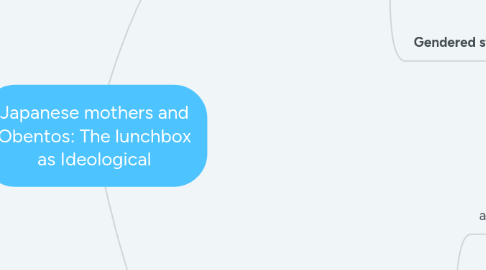
1. Obento
1.1. Nursery schools
1.1.1. most are private
1.1.1.1. the yoichen (nursery school) - social orders are established
1.1.2. starting school signifies the "real world".
1.2. box lunchbox prepared by mothers for their children in Japan to go to nursery school
1.2.1. moms spend 20-45 minutes making it, organize a supper meal with leftovers for the obento of the next day.
1.2.1.1. children are taught to eat the whole meal in school rituals
1.2.1.1.1. the obentos stop around 1st grade
1.2.1.1.2. the encouragement to finish the obentos in school is addressed by the teacher
1.2.2. purpose is to aid entering the "real world" of school
1.3. artfully crafted small portion foods
1.3.1. five/six course mini meals
1.4. Gendered state ideology
1.4.1. Producer of obento is deemed to be a woman, consumer is the child.
1.4.2. Althussers concept of Ideological state Apparatus (1971).
1.4.3. is supposed to signify being a good mother
1.4.3.1. one of biggest concerns/worry for a mom when the child goes to school for the first time.
1.4.4. Ministry in education (Monbusho)
1.4.4.1. school teaches children to think and prepare them for societal roles into adulthood
1.4.4.1.1. every public school has same curriculum, with set textbooks on a reading list
1.4.4.2. gakureki shakkai (lit academic pedigree society)
1.4.4.2.1. adult careers are determined by what schools they went to as kids
1.4.4.3. has influence on the importance of school attendance
2. Japanese food
2.1. appearance as a key element
2.1.1. food needs to be arranged as neat and visually attractive as possible
2.1.1.1. presentation is almost as important as how good the food tastes.
2.2. A taste of Japan (1985)
2.2.1. code for food
2.2.1.1. smallness
2.2.1.1.1. there are no large dinner plates like in America.
2.2.1.2. seperation
2.2.1.2.1. opposition
2.2.1.3. fragmentation
2.2.1.4. natural
2.2.1.4.1. stress importance of fresh food by ingredients
2.2.1.4.2. recreating nature "artificially"
2.2.1.5. order to the food
2.2.1.5.1. 1) a right way to arrange and coordinate
2.3. rice
2.3.1. Japanese say they are only full when they have eaten rice in a certain meal or once in the day (minimum).
2.3.2. dishes are usually centered around rice. core of the dish
